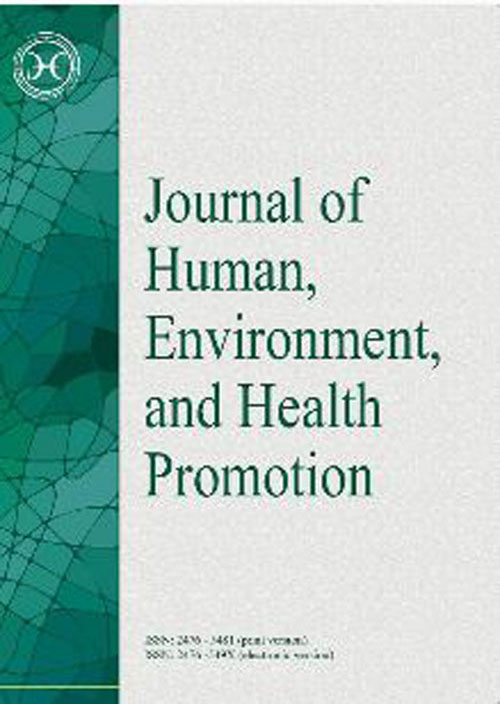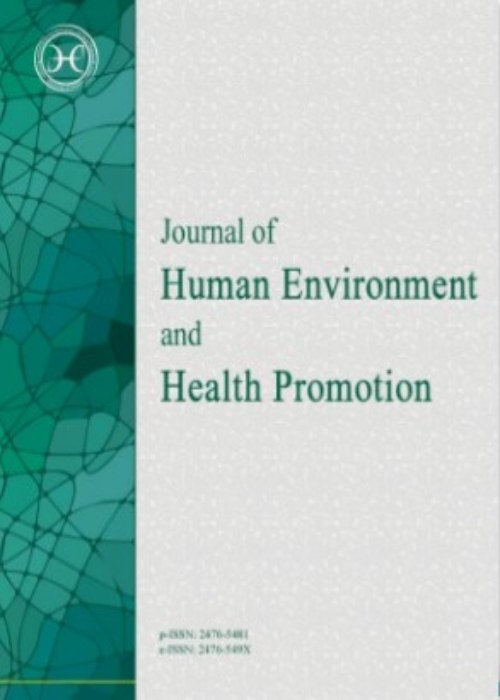فهرست مطالب

Journal of Human Environment and Health Promotion
Volume:7 Issue: 1, Winter 2021
- تاریخ انتشار: 1400/03/08
- تعداد عناوین: 8
-
-
Pages 1-5Background
Circular economy is gaining global acceptability, and its practice is rather poor in Nigeria similar to other developing countries. COVID-19 pandemic has caused enormous amounts of hazardous wastes, which require special attention. The present study aimed to assess circular economy and waste management actions during the COVID-19 pandemic in Nigeria.
MethodsData were collected using quantitative and qualitative methods and analyzed to determine the challenges of hazardous waste management in Nigeria by two notable healthcare centers in Ilorin as the cases. In total, 204 questionnaires were distributed among the staff, and 202 (99%) were returned.
ResultsThe respondents were 102 men (50.5%) and 100 women (49.5%) with various disciplines, including health workers (n=104; 51.5%), maintenance staff (n=42; 20.8%), and cleaners/waste handlers (n=56; 27.7%). The majority of the subjects (97%) believed that COVID-19 wastes should be segregated, while 111 subjects (55%) rated the management of personal protective equipment to be appropriate during the pandemic.
ConclusionAccording to the results, the implementation and enforcement of national policies regarding solid waste management are essential through the training and retraining of staff on hazardous waste management in the studied healthcare centers.
Keywords: Solid waste, Circular economy, COVID-19, Hazardous waste management, Isolation center -
Pages 6-14Background
Heavy metal toxicity at low levels damages the function of the brain, lungs, kidney, liver, blood composition, and other important organs. Long-term exposure leads to gradual disease progression in multiple sclerosis, Parkinson’s disease, Alzheimer’s disease, muscular dystrophy, and cancer.
MethodsIn total, 100 crustacean samples (50 crabs and 50 prawns) were analyzed in terms of nickel, zinc, chromium, and copper residues using an atomic absorption spectrophotometer and compared to Egyptian standard limits.
ResultsThe concentrations of nickel, zinc, chromium, and copper in the crab samples were 0.292 ± 0.02, 20.688 ± 3.06, 1.158 ± 0.01, and 22.304 ± 4.04 µg/g of wet weight, respectively. The values in the prawn samples were 0.373 ± 0.01, 16.204 ± 2.01, 0.844 ± 0.01, and 18.524 ± 1.03 µg/g of wet weight, respectively.
ConclusionOur findings could lay the groundwork for monitoring the heavy metal contamination of marine organisms. The estimated daily detection intake of nickel, zinc, chromium, and copper was below the reported PTDI of each element. In addition, the THQ and HI values of the heavy metals were below 1.00 in the crab and shrimp samples, suggesting no significant risks to the community health due to the consumption of the crab and shrimp samples.
Keywords: Heavy metals, Crab, Prawn, Risk assessment -
Pages 15-21Background
The overall purpose of this study was to estimate the health risk of nitrate (NO3-) concentration in the drinking water of Tabriz County.
MethodsThis research is a descriptive cross-sectional study that was performed on Tabriz drinking water in 2016-2017. The concentration of NO3- in one hundred - ninety drinking water samples was determined in the water and wastewater laboratory of the provincial health center using spectrophotometry.
ResultsThe results showed that the average levels of NO3- (as nitrate ion) in drinking water of urban and rural districts were 14.6 ± 12.8 and 13.1 ± 12.8 mg/L, respectively, which are lower than the national standard of Iran and WHO guidelines. The average hazard quotient (HQ) for four age groups of infants, children, teenagers, and adults was less than one in both urban and rural zones. However, HQ values for the children were more than 1 in 15.20% of urban and 10.7% of rural samples.
ConclusionThe non-carcinogenic risk of NO3- in drinking water does not threaten the exposed population, but the children presumably are at risk of NO3-. Hence, the continuous control of the concentration of NO3- was recommended to prevent its possible risk for water consumers, especially children.
Keywords: Risk assessment, Nitrate, Water pollution, Hazard quotient, Tabriz -
Pages 22-29Background
Zinc production due to applying mineral soils as raw material and high rate of tailings and wastes lead to environmental and health challenges, such as total suspended particle (TSP) emissions.
MethodsThis was the first study to monitor TSP concentration fluctuations and location variability in Zanjan zinc industrial park (ZZIP), Iran for 11 months. Nine stations equipped with an LVS were selected for TSP sampling from air simultaneously. Sample analysis was performed in the laboratory using gravimetric methods and data depicted by ArcGIS to recognize spatial distribution.
ResultsChanges in TSP concentrations were within the range of 30.17-2,692.82 μg/m3 and exceeded the EPA/WHO guidelines in more than 98% of the cases. Spring and winter showed the highest levels. The main influential factors in the TSP concentration were industrial activities, vicinity to the depot site and main streets, the speed of passing vehicles, and the dominant wind direction.
ConclusionDespite recent attempts to control TSP, the concentrations remain high and alarming. Therefore, special attention must be paid to the health issues affecting staff and residential groups and implementation of more effective control mechanisms.
Keywords: Air Pollution, Industrial Pollution, Total Suspended Particles (TSP), Mapping -
Contamination Rate of Bovine Raw Milk with Yersinia enterocolitica Biotypes in the Northeast of IranPages 30-34Background
Yersiniosis is an important foodborne zoonotic disease worldwide. Gastroenteritis and septicemia are the primary forms of yersiniosis. Yersinia enterocolitica is a causative organism, which is frequently isolated from foods such as milk. This study aimed to evaluate the contamination rate of bovine raw milk with Y. enterocolitica during January-July 2017 and the biotyping of the isolated organisms.
MethodsIn total, 100 bovine raw milk samples were collected from Mashhad, Iran. The samples were enriched in peptone sorbitol broth. After alkali treatment, the enriched samples were streaked onto cefsulodin-irgasan-novobiocin agar plates. Suspected colonies of Y. enterocolitica were tested by the amplification of the 16s rRNA gene to confirm the isolates as Y. enterocolitica. The confirmed isolates were biotyped using biochemical tests.
ResultsThe results showed that 33% of the bovine raw milk samples were contaminated with Y. enterocolitica. Biotype 1A was predominant (26%), while the pathogenic biotypes 1B (6%) and 5 (1%) were also detected.
ConclusionAccording to the results, the isolation of pathogenic Y. enterocolitica from bovine raw milk is a public health hazard due to its presence in dairy products.
Keywords: Yersinia enterocolitica, Milk, Yersinia, Sample enrichment, 16s rRNA gene -
Pages 35-40Background
The present study aimed to investigate the protective effects of selenium nanoparticles in a lead-induced testicular toxicity model.
MethodsIn total, 30 Wistar rats were divided into three groups and treated (except the normal control) with lead acetate in drinking water (1,000 mg/l) for five weeks. The control rats and negative control rats received saline intraperitoneally, and the third group received intraperitoneal injections of selenium nanoparticles (0.5 mg/kg).
ResultsThe lead-treated group showed a significant increase in blood urea nitrogen, serum creatinine, serum aspartate aminotransferase (AST), serum alanine aminotransferase (ALT), and malondialdehyde levels (P < 0.01). The lead-intoxicated rats treated with selenium nanoparticles showed a significant decrease in serum AST and ALT compared to the untreated negative controls (P < 0.5). The histopathological examination of liver and kidney tissues indicated lead-induced injuries (e.g., necrotic cells in liver and kidneys). The selenium-treated group showed reduced histopathological signs of lead-induced injuries. Lipid peroxidation levels were also lower in the selenium-treated rats compared to the negative controls (P < 0.05).
ConclusionThis experimental study confirmed the protective effects of selenium nanoparticles in the rats exposed to chronic lead-induced toxicity. However, further experiments are required to evaluate the possible side-effects and complications.
Keywords: Lead acetate, selenium nanoparticles, liver, kidney, Toxicity -
Pages 41-53Background
The Iranian Food Manufacturing and Producing Industries (IFMPI) were evaluated by the Iranian evaluator team according to the guidelines of the industrial projects before entering the full-scale implementation step. The current cluster study followed the objective of a similar research about evaluating the initial data of 57 various kinds of IFMPI in terms of energy, materials streams, and technical aspects.
MethodsThe present research took into consideration the assessment of initial data in the screening step of project identification to further processing via Multi-Criteria Decision Making (MCDM) models and developing a techno-economic assessment model empirically.
ResultsA good reliability ( a = 0.808) among the weight values in MCDM models confirmed a developed classification. The proposed economic assessment model is able to estimate the outlays for the screening step of IFMPI projects.
ConclusionIt can be concluded that the present study executed IFMPI in input and output materials besides energy streams and placed them in the reliable ranking levels using MCDM models along with Data Envelopment Analysis (DEA).
Keywords: MCDM models, Food manufacturing, Food processing practices, Industries -
Pages 54-59Background
Nutritional satisfaction is essential to the reduction of hospital costs given the faster recovery of patients. Food satisfaction may be influenced by self-operating or contractor food service management. This descriptive study was aimed to assess patient satisfaction with the dinner served in two hospitals of Tabriz, Iran by contractors and a self-operating system in 214 participants during April-May 2014.
MethodsData were collected using a researcher-made questionnaire with 20 items on demographic and food satisfaction data. Data analysis was performed in SPSS, and the intragroup and intergroup differences were evaluated and compared at the significant P-value of less than 0.05.
ResultsOverall food satisfaction was significantly higher in hospital A (contractor-supported food service) compared to hospital B (self-operating food service) (P < 0.001). In addition, a negative correlation was observed between food satisfaction and the literacy level of the subjects. Having a companion also reduced the satisfaction score of the patients.
ConclusionOur findings could provide useful information for the legislation of new policies to increase the food satisfaction of inpatients and exploit its advantages, while contributing to the decision-making regarding the choice of financial support for hospital food services.
Keywords: Food satisfaction, Self-operating food service, Contracting food service


